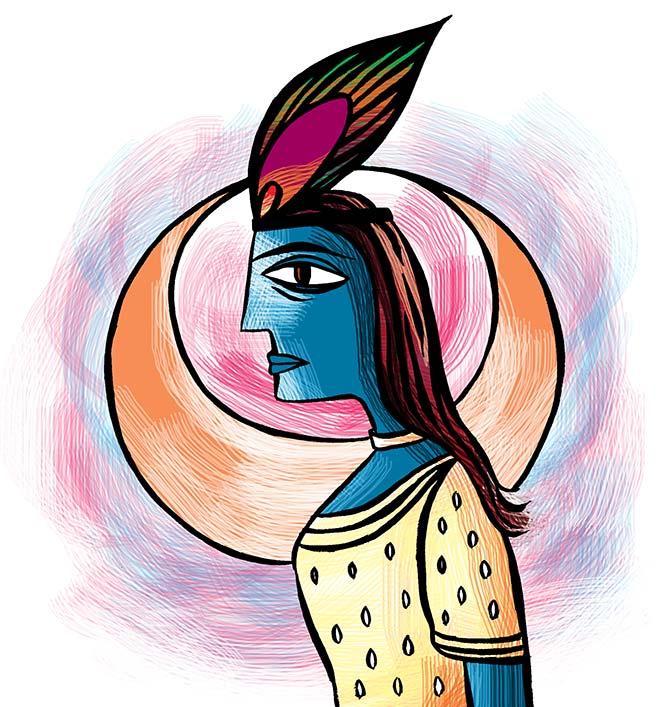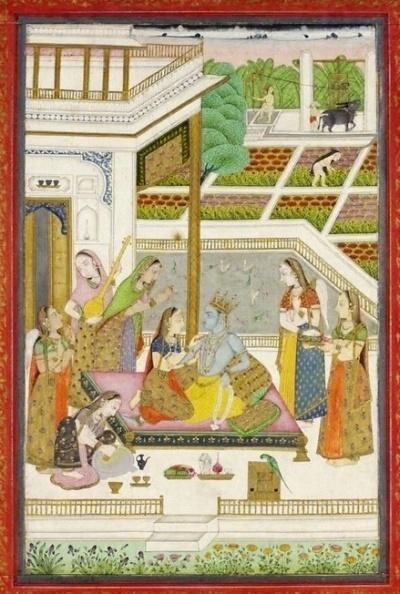 | « Back to article | Print this article |
'She exists alongside Sita, the archetype of the ideal woman,' notes Arundhuti Dasgupta.

What is love? This question, Google informs us, was the most searched string on its platform, in the run up to Valentine's Day.
Not much appears to have changed from the time when hundreds and thousands of years ago poets posed the same question to speak of the indefinable relationship between Radha and Krishna.
Neither age nor time seems to have thrown up an answer, nor dimmed the pursuit for one.
Love of the kind that Radha and Krishna embodied was taboo.
An older married woman in love with a boy is a proposition that sits uncomfortably with most even today.
But the fact that it was accepted then as it is now is what keeps the intrigue and interest alive.
The story has not only survived, but is even held up as a symbol of the purest love by all -- be it the mystic poets or Krishna-worshippers.
For everyone Radha's love is eternal, unbounded and selfless -- something that the rest of the world can only aspire to, but never reach. So, too, is the desire to understand Radha, as heroine, goddess and lover.
The collection of essays in the book filters her story through multiple lenses.
While scholars trace her lineage through oral, textual and the vast and varied body of performance arts in the country, the devotional songs and poetry lets us into the world that views her as a goddess.
While this is perhaps the only way to include the many different ways in which Radha has permeated the social consciousness, it could be confusing to those looking for definitive pronouncements and answers.
So even as the light shines brightly on every aspect of her character, Radha continues to be elusive.
Namita Gokhale writes in her introduction to the book that she co-edited with Malashri Lal that Radha was an enigma.
And it is a marvel of the times and prevalent social structures that afforded her the role of a goddess, so much so that she exists alongside Sita, the archetype of the ideal woman.
Just as intriguing is Radha's pan-Indian appeal. Despite her geographical moorings in central and north India, Radha is sung about and worshipped in almost every state in the country.
There are very few goddesses/literary characters that carry a similar countrywide currency.

Lal writes that almost nothing is known of the origins of Radha except in the folklore of Barsana (in the Mathura district in Uttar Pradesh) where she is ensconced in a temple with her parents and sibling.
Here, her love for Krishna and her social acceptance are a part of the collective memory of the region.
In the songs that are sung here in the local language, Radha and Krishna behave like a lovelorn couple; in its geography, there are traces of the time they spent together marking out the sacred spots for present-day visitors.
For example, there is a pond where Yashoda is said to have applied turmeric to Radha's palms as a sign of her acceptance as Krishna's bride.
The place is a tourist attraction and, for many, evidence of the presence of the divine on earth.
Several essays in the book make a distinction between the Radha that exists in the folk imagination (as in Barsana) and that of the classical version (in the texts and poetry).
Jawhar Sircar ('In Search of the Historical Radha') writes that the first Hindu text to refer to Radha, and that too rather indirectly, is the Bhagawat Purana where she is Krishna's favourite lover, but is never named.
She does find stray references in other Puranas, but it is only in poet Jayadeva's Gita Govinda that she emerges as a full-fledged character.
Jayadeva composed in the 12th century and wrote in a strange mix of Sanskrit and Apabhramsa, one of the non-Sanskrit languages spoken in the country at the time.
His poetry and then later that of Chandidas (Bengali) and Vidyapati (Maithili) introduce the element of divinity in the love that Radha and Krishna profess for each other.
Their poetry helped give rise to songs and an overall sense of oneness between the two in the popular imagination -- poets such as Kazi Nazrul who wrote several songs about Radha is best known (arguably) for the one where he has Radha telling Krishna that if only he were her would he know the love that burned through her.
Makarand Paranjape ('Enjoying God: The Divine Paramour') says the credit for Radha's exalted status today goes to Jayadeva who first drew her as a figure soaked in Krishna's love, thereby making her a key character in the rise of the Vaishnavite Bhakti cult.
Both Radha and Krishna are comfortable in each other's skin and one of the essays ('Becoming Radha' by Alka Pande) has a story that illustrates how people imagined their love.
Pande writes that jealous gopis (milkmaids and Krishna's lovers) brought Radha a bowl of scalding hot milk, saying that Krishna had sent it for her.
She drank it down without any discomfort, but Krishna fell down, writhing in pain instead.
That the two are one body, one soul, is a recurring theme in literature and their worship even today.
The Bauls (folk singers of Bengal) sing about their sublime love even today.
Popular songs dress her as Krishna, wearing his yellow robes and peacock feathered crown and vice versa.
Their love is also seen by many today as being one of the most gender-fluid relationships between a man and a woman in the ancient world.
What makes Radha, a woman who had an extra-marital affair with a boy much younger than herself, a timeless goddess? The answer lies with the poets who drew her out of the shadows of oral narratives and the recesses of Vedic-Puranic literature.
By imbuing a romantic sensibility, they made her relatable and closer to the people.
Radha is not worshipped out of fear, nor does she have the power to redeem sinners or bestow boons.
Human, frail and completely devoted to her lover renders her appeal timeless and mysterious. But that is also what makes her difficult to find.